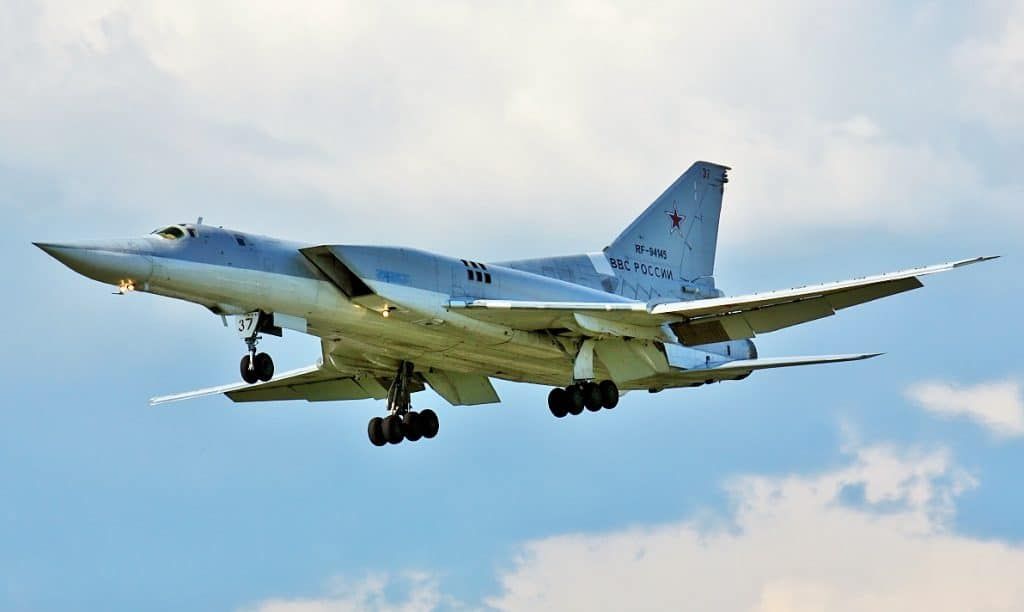Russian military doctrine calls a limited nuclear strike “de-escalation.” Here’s why.
By Nikolai N. Sokov | March 8, 2022
 The Russian Tupolev Tu-22M3M can deliver nuclear weapons by missiles or by gravity bombs. Image originally posted to Flickr by Dmitry Terekhov at: https://flickr.com/photos/44400809@N07/19230388334. Licensed under cc-by-sa-2.0.
The Russian Tupolev Tu-22M3M can deliver nuclear weapons by missiles or by gravity bombs. Image originally posted to Flickr by Dmitry Terekhov at: https://flickr.com/photos/44400809@N07/19230388334. Licensed under cc-by-sa-2.0.
Editor’s note: This article was originally published in 2014, as Russia was seizing Crimea. It is being published in updated form here because of its obvious relevance to the current Russian invasion of Ukraine, and to Russian President Vladimir Putin’s recent threats regarding the use of nuclear weapons.
In 1999, at a time when renewed war in Chechnya seemed imminent, Moscow watched with great concern as NATO waged a high-precision military campaign in Yugoslavia. The conventional capabilities that the United States and its allies demonstrated seemed far beyond Russia’s own capacities. And because the issues underlying the Kosovo conflict seemed almost identical to those underlying the Chechen conflict, Moscow became deeply worried that the United States would interfere within its borders.
By the next year, Russia had issued a new military doctrine whose main innovation was the concept of “de-escalation”—the idea that, if Russia were faced with a large-scale conventional attack that exceeded its capacity for defense, it might respond with a limited nuclear strike. To date, Russia has never publically invoked the possibility of de-escalation in relation to any specific conflict. But Russia’s policy probably limited the West’s options for responding to the 2008 war in Georgia. And it is probably in the back of Western leaders’ minds today, dictating restraint as they formulate their responses to events in Ukraine.
Game-changer. Russia’s de-escalation policy represented a reemergence of nuclear weapons’ importance in defense strategy after a period when these weapons’ salience had decreased. When the Cold War ended, Russia and the United States suddenly had less reason to fear that the other side would launch a surprise, large-scale nuclear attack. Nuclear weapons therefore began to play primarily a political role in the two countries’ security relationship. They became status symbols, or insurance against unforeseen developments. They were an ultimate security guarantee, but were always in the background—something never needed.
Then a very different security challenge began to loom large in the thinking of Russia’s political leaders, military officers, and security experts. That challenge was US conventional military power. This power was first displayed in its modern incarnation during the Gulf War of 1990 and 1991—but the game-changer was the Kosovo conflict. In Yugoslavia the United States utilized modern, high-precision conventional weapons to produce highly tangible results with only limited collateral damage. These conventional weapons systems, unlike their nuclear counterparts, were highly usable.
The Russian response, begun even before the conflict over Kosovo had ended, was to develop a new military doctrine. This effort was supervised by Vladimir Putin, then-secretary of Russia’s Security Council, a body similar to the National Security Council in the United States. By the time the doctrine was adopted in the spring of 2000, it was Putin who signed it in his new capacity as president.
The doctrine introduced the notion of de-escalation—a strategy envisioning the threat of a limited nuclear strike that would force an opponent to accept a return to the status quo ante. Such a threat is envisioned as deterring the United States and its allies from involvement in conflicts in which Russia has an important stake, and in this sense is essentially defensive. Yet, to be effective, such a threat also must be credible. To that end, all large-scale military exercises that Russia conducted beginning in 2000 featured simulations of limited nuclear strikes.
De-escalation rests on a revised notion of the scale of nuclear use. During the Cold War, deterrence involved the threat of inflicting unacceptable damage on an enemy. Russia’s de-escalation strategy provides instead for infliction of “tailored damage,” defined as “damage [that is] subjectively unacceptable to the opponent [and] exceeds the benefits the aggressor expects to gain as a result of the use of military force.” The efficacy of threatening tailored damage assumes an asymmetry in a conflict’s stakes. Moscow reasoned when it adopted the policy that, for the United States, intervening on behalf of Chechen rebels (for example) might seem a desirable course of action for a variety of reasons. But it would not be worth the risk of a nuclear exchange. Russia, however, would perceive the stakes as much higher and would find the risk of a nuclear exchange more acceptable. Indeed, in the early 2000s, Russian military experts wrote that US interference in the war in Chechnya could have resulted in a threat to use nuclear weapons.
The new strategy did not come out of the blue. Its conceptual underpinnings follow from Thomas Schelling’s seminal books The Strategy of Conflict and Arms and Influence. At the operational level, the strategy borrows from 1960s-era US policy, which contemplated the limited use of nuclear weapons to oppose “creeping” Soviet aggression (as expressed, for example, in a 1963 document produced by the National Security Council, “The Management and Termination of War with the Soviet Union”).
How and where? Common sense might suggest that any limited use of nuclear weapons for de-escalation purposes would involve non-strategic (shorter-range) weapons. But this does not appear to be the thinking. In 2003, the Ministry of Defense issued a white paper that dotted the new doctrine’s i’s and crossed its t’s. The white paper emphasized, among other things, that because the United States could use its precision-guided conventional assets over significant distances, Russia needed the ability to deter the use of those assets with its own long-range capabilities.
Accordingly, simulations of the limited use of nuclear weapons have featured long-range nuclear-capable systems (long-range air-launched cruise missiles above all, but medium-range bombers as well). To the extent that one can determine the targets that have featured in these exercises, they seem to be located over much of the world—Europe, the Pacific, Southeast Asia, the Indian Ocean, and even the continental United States. Targets appear to include command and control centers as well as airbases and aircraft carriers from which US aircraft could fly missions against Russia. In other words, for limited-use options, Russia appears to target military assets rather than the population or economic centers that were typical targets under Cold War strategies.
It is important to note amid all this that Russia’s nuclear weapons are assigned only to conflicts in which Russia is opposed by another nuclear weapon state. When Russia was preparing the 2010 edition of its military doctrine, some proposed that the possibility of using nuclear weapons be expanded to more limited conflicts, such as the 2008 war with Georgia—but this proposal was rejected. Ultimately the 2010 doctrine tightened conditions under which nuclear weapons could be used. Whereas the 2000 document allowed for their use “in situations critical to the national security” of Russia, the 2010 edition limited them to situations in which “the very existence of the state is under threat.” (Otherwise, the nuclear component of military doctrine remained fundamentally unchanged from 2000.)
Lessons acknowledged? Nuclear weapons command attention and generate fear. But their utility is limited. Outside the most extreme circumstances, the damage they can inflict is simply too great and horrible for the threat of using them to be sufficiently credible. Furthermore, nuclear deterrence is fundamentally a defensive strategy—capable of deterring attack but incapable of supporting a proactive foreign policy. The United States, because of its conventional military power, is able to pursue a proactive foreign policy, and this has long been the envy of Russia’s politicians and military leaders.
The 2000 version of Russia’s military doctrine characterized the limited use of nuclear weapons as a stopgap measure to be relied on only until Russia could develop a more modern conventional strike capability, similar to that which the United States possessed. Russia’s efforts to develop such a capability have been under way for more than a decade. Progress was slow at first due to chronic underfunding and the poor state of the Russian defense industry. The substandard performance of Russia’s conventional forces during the 2008 war in Georgia led many to dismiss the idea that Russia would ever match the United States in conventional capabilities. But Moscow learned lessons from its Georgian experience, and modernization efforts have intensified in the last five years.
Today, Russia can boast of a new generation of long-range air- and sea-launched cruise missiles, as well as modern short-range ballistic and cruise missiles and precision-guided gravity bombs. Theoretically, the cruise missiles could carry nuclear warheads, but their envisioned role is primarily conventional. Additionally, Russia’s GLONASS satellite constellation now enables precision targeting and communications across the globe. Russia has also begun developing a global strike capability, analogous to the US Prompt Global Strike initiative, in the form of a new intercontinental ballistic missile that the military has said is primarily intended to carry conventional warheads.
Military maneuvers conducted last year, known as West 2013, were apparently the first large-scale Russian exercises since 2000 that did not feature the simulated use of nuclear weapons. This hints that Moscow has gained more confidence in its conventional capabilities. As these capabilities continue to improve, Russia is likely to rely less on its nuclear weapons. But this shift will significantly alter the Eurasian security landscape.
If Russia becomes able to project military force in the same way that the United States has projected force in Kosovo, Iraq, and Libya, Moscow will likely become more assertive in its foreign policy. This will affect NATO policy in turn. The alliance, owing in large measure to US dominance in conventional military power, has been able in recent years to reduce (though not eliminate) its reliance on nuclear weapons. But if Russia begins to close the conventional weapons gap with the United States, some NATO countries might argue that nuclear deterrence should regain some of its former prominence.
Thus, though Russia’s reliance on nuclear weapons, including their “limited” use, is not good for international security, the likely alternative will hardly enhance security either. To avoid a new arms race—one centered around conventional weapons, which are less terrifying but more usable than nuclear weapons—it makes sense to begin work now on arms control options that would cover modern conventional strike and defense assets. Unfortunately, the majority of the US Congress refuses to consider arms control arrangements for classes of weapons in which the United States currently enjoys an advantage. But as history has demonstrated, no technological advantage lasts forever. One hopes that those capable of averting a new arms race acknowledge history’s lessons before it’s too late.
Together, we make the world safer.
The Bulletin elevates expert voices above the noise. But as an independent nonprofit organization, our operations depend on the support of readers like you. Help us continue to deliver quality journalism that holds leaders accountable. Your support of our work at any level is important. In return, we promise our coverage will be understandable, influential, vigilant, solution-oriented, and fair-minded. Together we can make a difference.
Keywords: Escalate to de-escalate, Russia, Ukraine, tactical nuclear weapons
Topics: Nuclear Risk, Nuclear Weapons















I think that the Doomsday Clock needs to be updated,sadly.
Russia has no desire to use NW vs Ukraine.
1) The Russian Senate has not passed such decision; 2) the Russian updated NW strategy does not permit to do so in the Ukrainian case; 3) Russia is quite successful to reach the announced goals without using NW in Ukraine by using prospective conventional munitions.